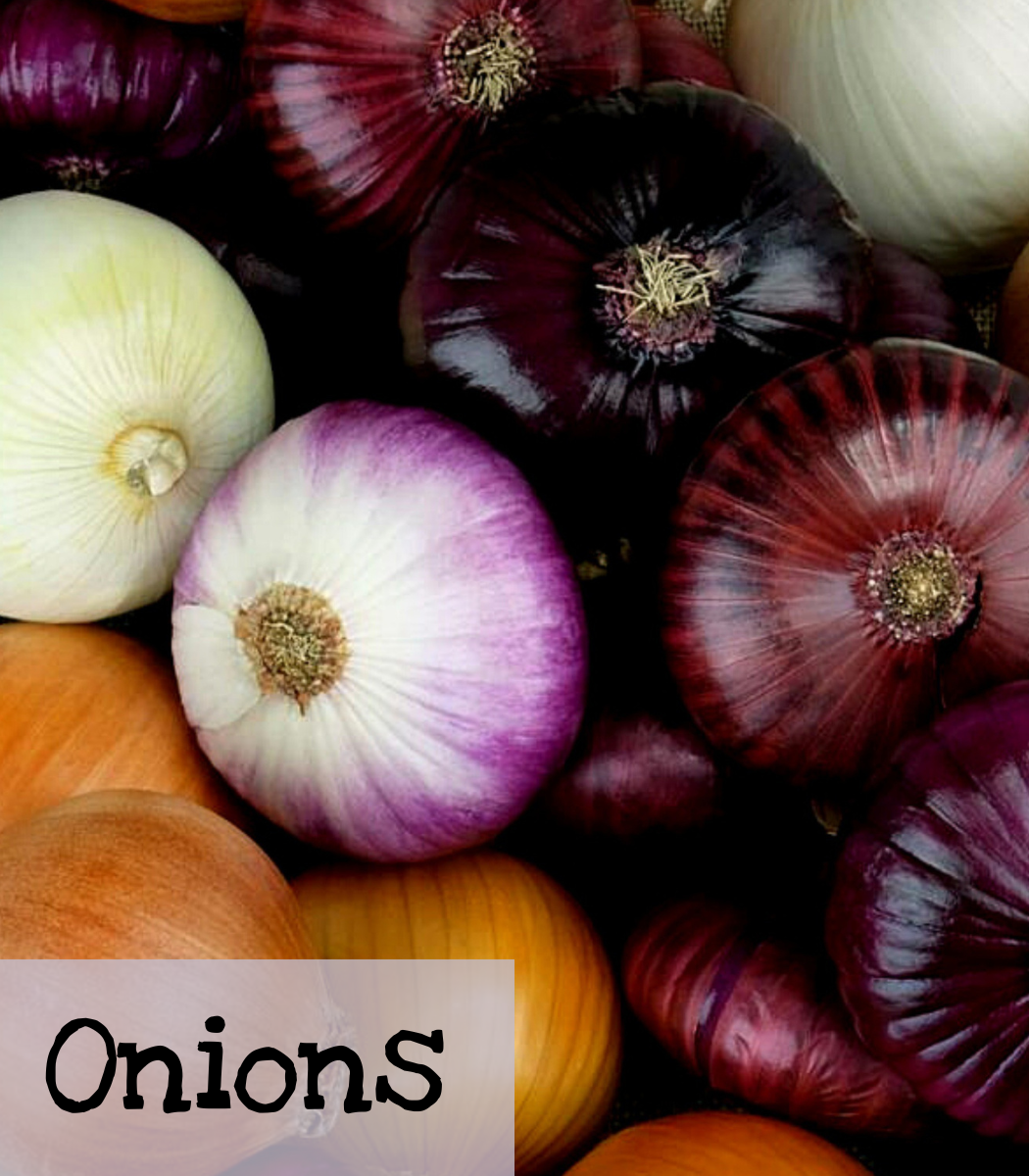
Onion
Onions are a member of the allium family and have some pest repellant properties.
|
Long Day: Evergreen Long White Bunching; Tropeana Lunga Bunching; Yellow of Parama Day Neutral: Ishikura Bunching; Parade Bunching; White Lisbon Bunching Short Day: Texas Early Grano |
|
Allium cepa |
|
Intermediate |
|
Intermediate |
|
1-2 years |
|
Most are biennial Some are perennial |
|
7-10 days |
|
None |
|
1/4 inch |
|
Small to Medium |
|
Full sun |
|
60-75 days for bunching 110 days for bulbing |
|
Special Seed Library Event: January August, September Special Seed Library Event: November-December |
|
Yes |

Growing Tips


10 plants per 12” container
When to Start
Spring: Start indoors three months before the last frost date. Transplant 4-6 weeks before the last frost. (Transplant Jan 1-Mar 15 for GA)
Fall: Start indoors 8-10 weeks before the first frost. Transplant 4-6 weeks before the first frost. (Transplant Sep 1-Dec 31 for GA)
How to Start
Choose the right kind of onion for your area. There are short-day onions and long-day onions. Short-day onions are recommended for southern states. These will form bulbs during the winter months. While long-day onions are better for northern climates as they will form bulbs during the summer.
Starting onions from seed is a little different than starting from sets, where you are essentially transplanting seedlings. In Georgia, transplanting the onion seedlings can be done from fall through mid-March of the next year.
Onions can be slow starters. For spring, start indoors 3 months before the last frost date and transplant 4-6 weeks before the last frost.
Fall onions should be started indoors 8–10 weeks before transplanting. Sow ¼ inch deep into the seed starting mix and place them under grow lights. Seeds should germinate in 4-10 days. Transplant seedlings after hardening off.
Care
Onions require an open and sunny site, fertile soil, and good drainage. They do best in cooler temperatures. Transplant when the onions are 4-6 inches tall and plant most of the white stem. Before transplanting, make a large furrow in your soil, at least 4 inches deep. Water this furrow before planting your seedlings to make transplanting easier. Space the seedlings at least 4-6 inches apart. Mulch for over-wintering, as well as, to protect from freezes. Keep the soil moist and don’t let it completely dry out as this will harm the onions.
If you want to try to get bulbs (for short-day varieties), the trigger for bulb creation is the shorter days of winter. Once the days get too long, they’ll stop growing and usually rot. The risk for onion thrips also increases the closer to spring you get. Plant them soon enough to give the onions time to form bulbs in the short winter months.
Long-day onions need 14-16 hours of sunlight (long days of summer) to form bulbs but they don’t do well in the southern states.
Harvest
Harvest the greens when they are about the size of a pencil or 6 inches high. The greens will get stronger the more mature they are. You can even pull young onions and use them as a scallion. Otherwise, wait until the tops naturally fall over and brown. If they start to bloom, pinch off the blooms. Be careful of very soggy conditions as this will cause the bulbs to rot in the ground. If they have started to bolt, pull and use immediately.
Storage
Onions can be stored like garlic by braiding the stems and hanging them up. Store in a cool dry place.
Pro Tip!
Incompatibles: Beans, asparagus, peas, and sage
Grows well with: Lettuce, peppers, spinach, and tomatoes
My personal experience
We always had onions in the garden while I was growing up. So when I first got my own dirt to have a garden, onions were a must. I didn’t know way back then that there were short and long-day onions. I just picked up a set from one of those garden centers. I had an even smaller garden at the time, so they were planted next to my green beans.
I couldn’t figure out why I had piddly beans and my onions never bulbed or grew much bigger than when I started. I did a little “digging” and found out beans and onions don’t play nice with each other. I tried onions again the next year (planted far away from my green beans). I got sets from the same place. However, they didn’t do well either. They were probably a long-day variety.
I’m sure I’ll try again. But I’ll choose a short-day variety that is suited to my area. I have had success with growing green onions. I started them indoors as part of my growing lettuce year-round experiment. I eventually moved them outside. They did well even in the heat of summer.
Seed Saving

Isolation Distance
Separate varieties by 1-2 miles to prevent cross-pollination. Or plants can be caged or bagged and then hand-pollinated.
Instructions
To hand-pollinate, remove covers and use a fine, light paintbrush to mimic the action of visiting insects, thoroughly mixing pollen between several flowers. Make sure to hand-pollinate the flowers during a time (such as early morning or late evening) when insects are not present, and replace covers quickly and securely.
Allow seeds to ripen and dry on the plants, then harvest quickly to avoid losing seeds. Onion seeds are short-lived and should only be stored for one or two years before planting.
Features
Long Day
- Evergreen Long White Bunching: For full-sized onions, they need 14-16 hours of sunlight. Great for using as baby scallions.
- Tropeana Lunga Bunching: Heirloom. A long, tall, “torpedo” shaped red bulbs. Not a storage onion.
- Yellow of Parama: An Italian heirloom. Large oblong globes that store well.
Day Neutral
- Ishikura Bunching: Japanese Heirloom. Good for soups, salads, and sukiyaki. Gets very large, but stays tender. Never forms a bulb.
- Parade Bunching: A bunching onion that is mild but not bulb-forming.
- White Lisbon Bunching: Classic white scallions. Harvest after they are pencil sized.
Short Day
- Texas Early Grano: Heirloom. Short-day, extra sweet Vidalia-type that have a thin skin. They are frost-hardy. It is said they are so sweet that they can be eaten like an apple. (Maybe this is the variety grown in the book Holes by Louis Sachar. Just a thought!)

- Onions are very moisture sensitive, they can rot overnight. So keep an eye on the weather as it gets closer to harvest time.
- Bunching onions are used as scallions and will not typically make big bulbs. However, some like the evergreen long white will also form full-sized onions.
- Do NOT plant next to green beans. Neither will thrive and harvests will be small.
Sources:
Master Gardener Brandy Pethel-UGA
